
How To Do Long-Tail Keyword Research And Competitor Analysis For Free

Ranking high in search engines can be pretty tricky and time-consuming, especially if you’re not familiar with how to do long tail keyword research and competitor analysis.
If you’re a content producer running a blog, for example, you want to get your content in front of as many eyeballs as possible. The process in this post is going to show you how you can do free long-tail keyword research quickly, and also how to conduct a simple competitor keyword analysis.
Keyword research and competitor analysis can be done in different degrees of detail. This post’s outline of the process is focused on a quick and relatively simple approach which is great when getting started with it, or when you have limited time. Furthermore, it’s a completely free method.
Required tools:
- Google keyword planner
- Google Sheets
- SEMScoop
- Ahrefs.com (optional)
What is keyword research and why is it important?
Keyword research is a process you go through to find out what people are searching for in search engines. Keyword research should be done when trying to rank a content piece in the search engine when finding out what information people are looking for in order to generate ideas for new content when you’re planning a paid advertising campaign, or in relevance to other marketing-related objectives.
Doing this work is really important because you want to know which search terms people are typing into a search engine when looking for information. The more relevant your content is for what people are searching for, the more likely it is that people will find your content because the search engines are showing it to them. Ergo, more traffic for you!
What are long tail keywords?
Keywords that are short and broad typically give many results in the search results and are thus more competitive. Long tail keywords are more specific and consist of several words, often small phrases that people type into the search engine. They are less competitive because the longer phrase, the narrower the search intent. Long tail keywords also often have a higher conversion value, since they contribute to making the search hits more relevant to the person who is searching for them.
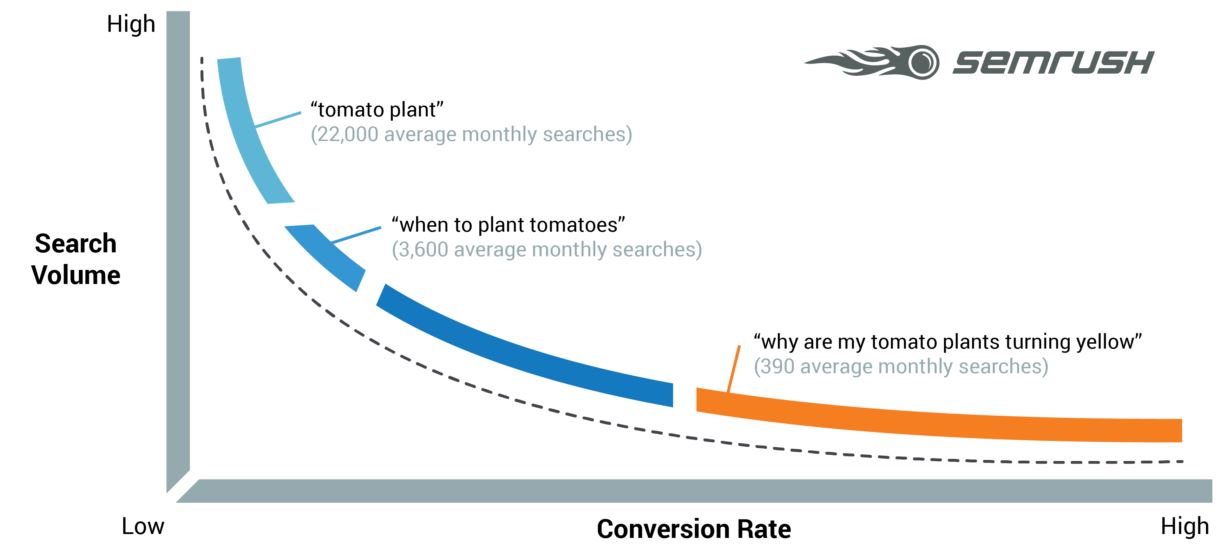

These keywords are what you want to target when doing your keyword research and competitor analysis.
The metrics
We are interested in some metrics when conducting our keyword research and when trying to paint a picture of the competition of those keywords.
Search volume – How many monthly searches that keyword gets every month
Competition – When using Google keyword planner for keyword research, google gives you a competition number between 0 – 100. the higher the number the more competitive keyword. In this post, we are focusing on keywords with a competition number of 30 or below.
Domain authority (DA) – This metric is a score of how likely a website is to rank on the first page of google for a keyword. Typically higher when the site is old and has many backlinks. The higher the number, the harder it is to outcompete.
Backlinks – Number of links pointing back to a website? This is an important metric for telling the search engines something about the quality of the page that is linked to.
If a page has many backlinks, the search engines interpret it as important, relevant, and quality content since many people are linking to it. Building backlinks to your own site is crucial for increasing your own domain authority.
Keyword difficulty – This metric tells us how difficult it is to rank for a specific term in search engines. It summarizes the competition by giving us a metric based on several factors, such as domain authority, content quality, and page authority.
Dependent on your own domain authority, you should do an evaluation of what the maximum keyword difficulty is relevant for you to compete in. If you’re just starting, try to find keywords in the 5-30 range. A keyword difficulty of 31 or more is considered as hard to rank for.
Related: The Big, Vital, All-in-One Guide to Keyword Difficulty
There are some free tools you can use to check these metrics. More on that later.
The long-tail keyword research and competitor analysis process
Ok, so how do we actually research keywords? Well, we’re going to use the Google Keyword Planner for this. You will have to sign up for a Google AdWords account in order to use this tool. It’s completely free and relatively fast to set up.
Now, let’s pretend we have a food blog that writes about how to make sushi.
We want to create a blog post on the topic of how to make california maki, and conduct keyword research to increase our chances of ranking on the first page of Google.
Brainstorming inside the keyword tool – First, we need to give the keyword planner tool some ideas of what keywords we’re looking for. So the first step is to suggest a maximum of 10 keywords or phrases directly inside the tool. Click the “Discover new keywords” option
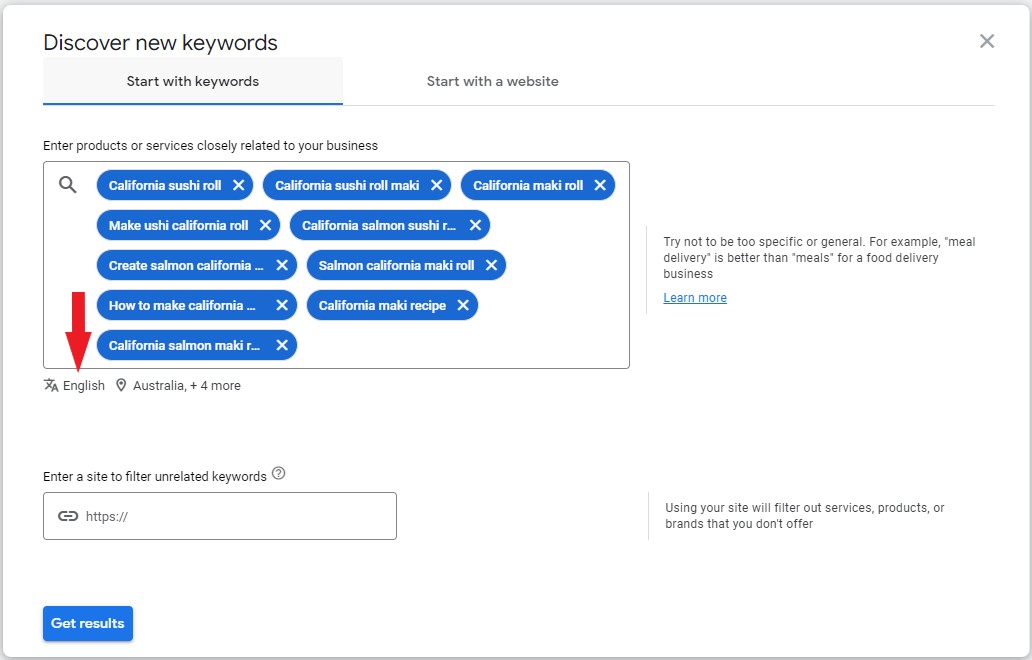

Just write out what you would search for yourself if you were looking for the information you’re about to create content on. I recommend that you write out a maximum of 10 phrases
Select area – Where do you want to be shown? Are you a local business? Then you should choose your local area or the city you live in. If you don’t need to customize your search to a local area, just choose the top-tier countries. I typically select USA, Canada, New Zealand, Australia, and Great Britain, and English as the language
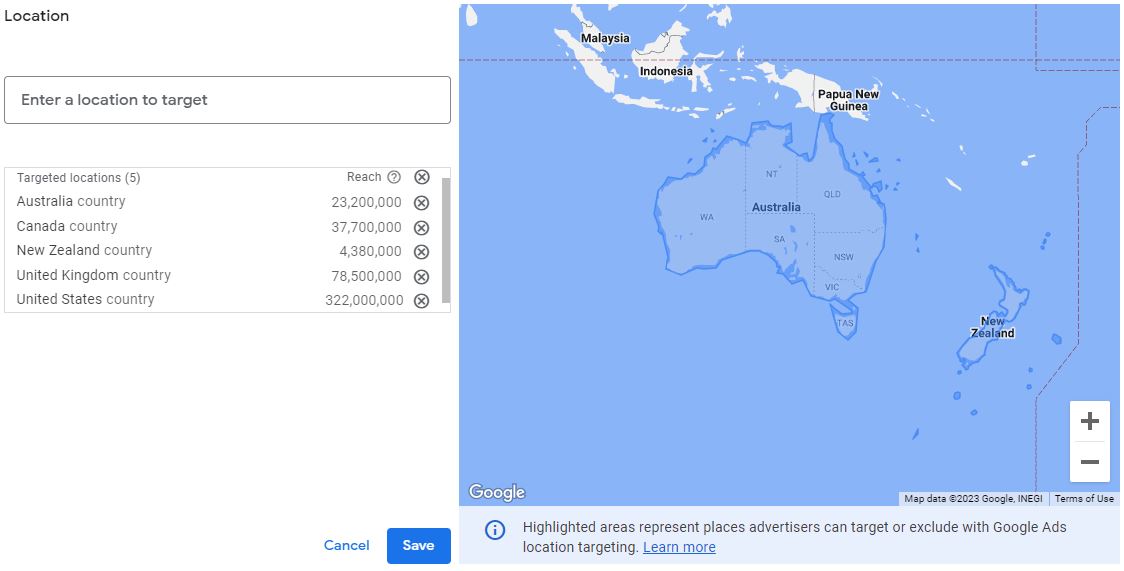

Click “Get results” and download the search results to Google Sheets from the button at the upper right corner of your screen.
When you have the list in front of you, delete all rows except row A-G. Keep the columns as in row 3 on the image below.
Ok so now you have the spreadsheet you’re going to work with. Go through these steps:
- Add a filter and remove keywords with too high competition (competition 30 or below). sort the competition row from Z-A.
- Delete all keywords with competition 31 or more.
- Filter the “avg. monthly searches” column to only show keywords with more than 50 searches.
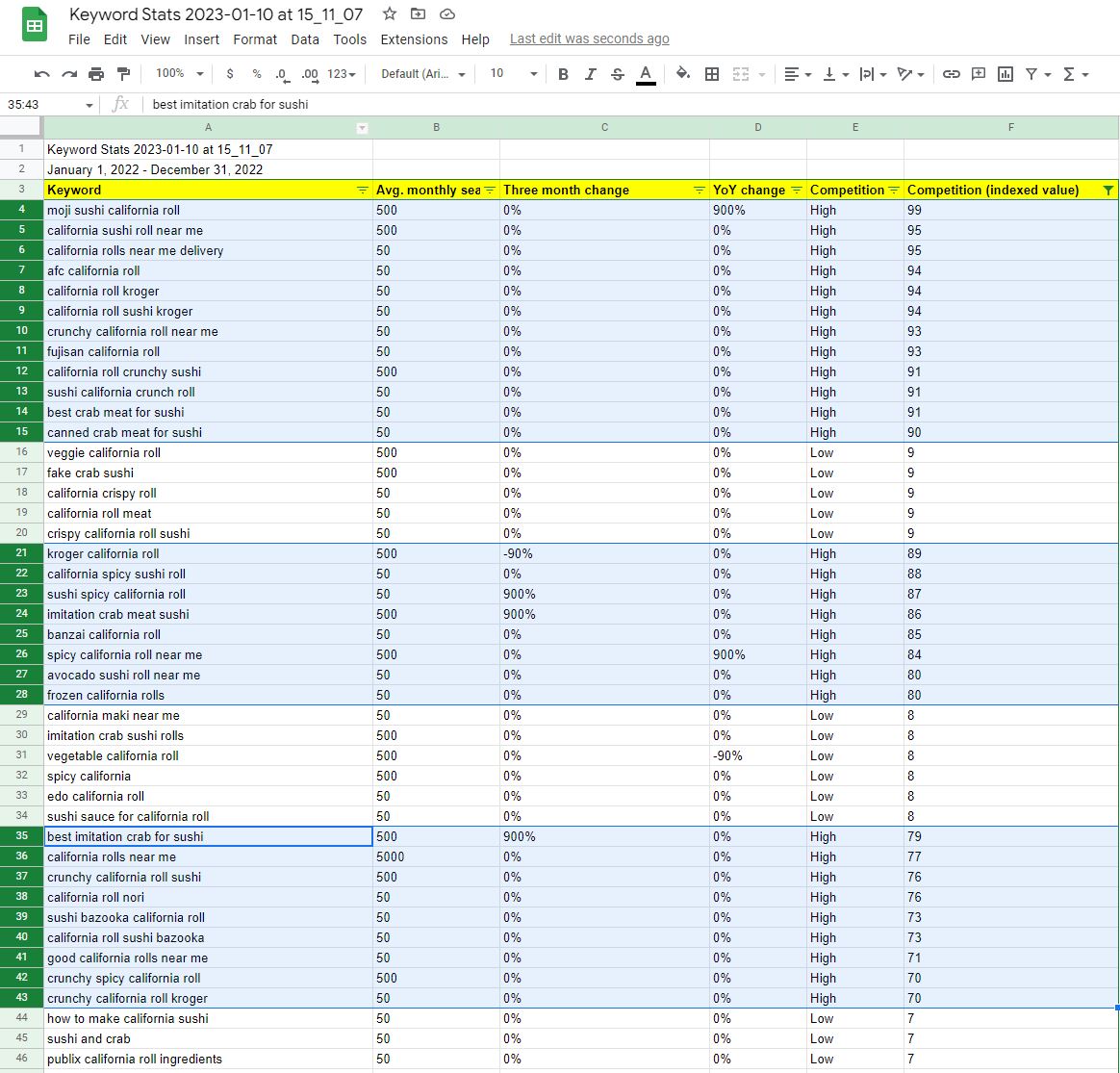

In this case, we are left with 87 keywords after this filtering and exclusion process.
Further, go through this list manually and color-code the keywords you want to select for the keyword competitor analysis. Like this:
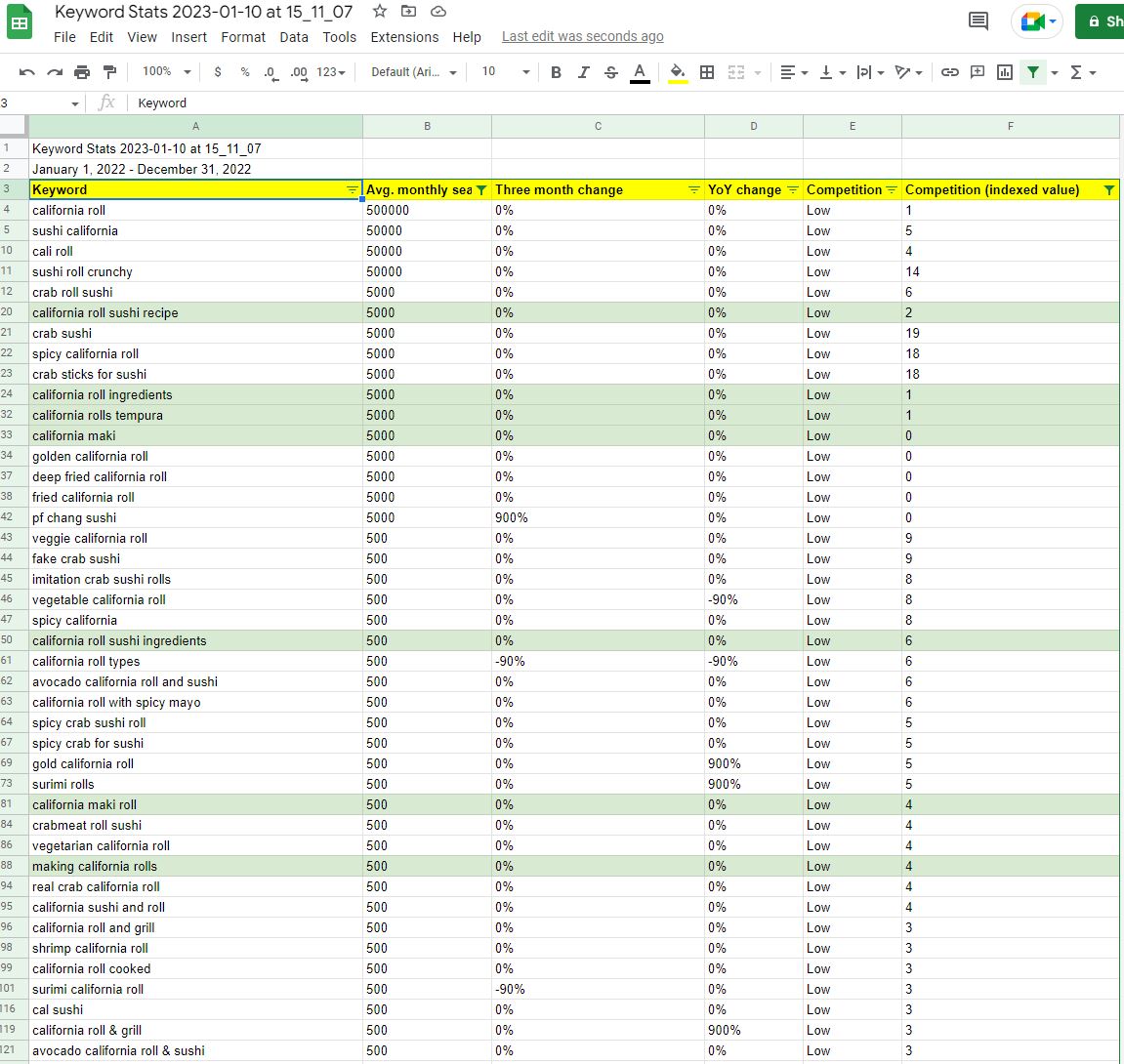

Now, sort by color code in the filtering to only see the keywords you selected in this step.
In this case, we want to go further with 13 keywords.
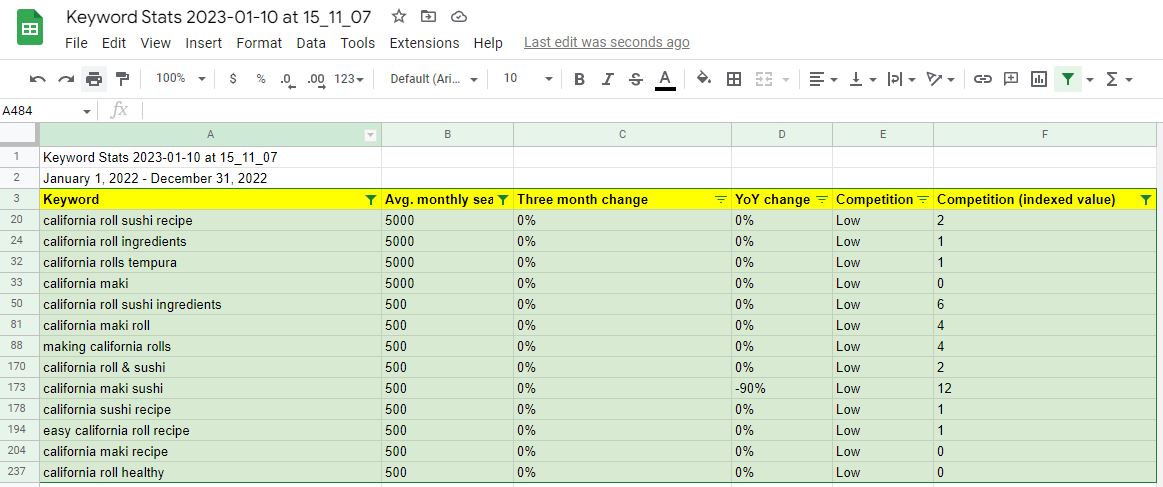

As you can see, the last keyword phrase is “california roll healthy”. That indicates that people are wondering how to make healthy sushi rolls. That’s a good idea for another content piece. Maybe we should create some content on how to make healthy sushi rolls. Anyway, we are ready to analyze the competition starting out with the keywords that have the most searches.
Quick competitor keyword analysis
Now that we have found our potential keywords, we are using SEMscoop for the first competitor analysis. Click here to go to the SEMScoop tool
In our case, we are going to start with the keyword “california roll sushi recipe” since it’s got a good search volume and a competition of 2. Turns out it is too competitive for us at this point.
In the free version of SEMScoop, you only have 5 searches a day. So keep that in mind when you do your searches in the tool. The next keyword we will try is a keyword we think is going to give us the results that we want. Let’s try the keyword “california maki recipe”.


SEMScoop tells us that the “california maki recipe” gets 1900 searches a month. This is a great search volume. The keyword difficulty of 33. That’s actually not bad.
Protip: Ahrefs provides some awesome free tools for finding competitor stats as well:
- Use Backlink Checker to find the number of backlinks on a page.
- Use Website Traffic Checker to check a webpages traffic
- Use Website Domain Authority Checker to find the correct DA
- Use Keyword Difficulty Checker to find the keyword difficulty
I checked the keyword difficulty on this keyword using the Ahrefs tool, and they estimate that we need about 15 backlinks to rank on the first page of Google, with a keyword difficulty of 13. That’s even easier than SEMScoop tells us, and really backs up the decision of targeting this keyword.
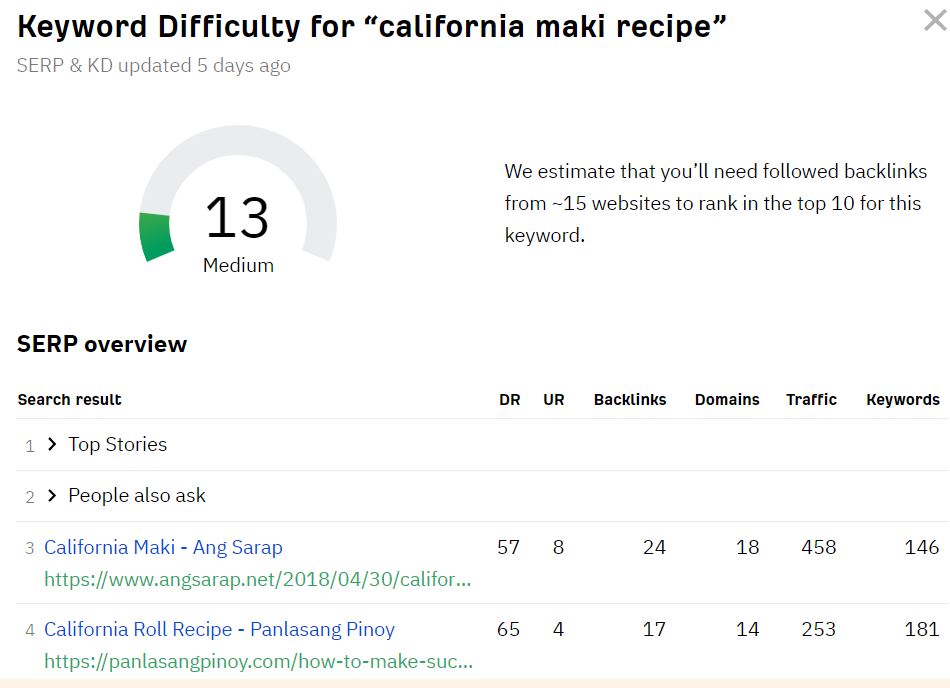

Ok, let’s take a look at the SERPs in SEMScoop. It shows us the top 8-10 results if you search for this term in Google. Now you’re looking for three things
- How many of the listed pages have the exact keyword match in their headline?
- How many of the listed pages have the exact keyword match in their URL slug?
- How many of the listed pages have the exact keyword match in their meta description?
As we can see from these results, it is only 1. Further, there is a page listed on the first page for this keyword with no backlinks and low domain authority of only 19. Another page has only 2 backlinks.
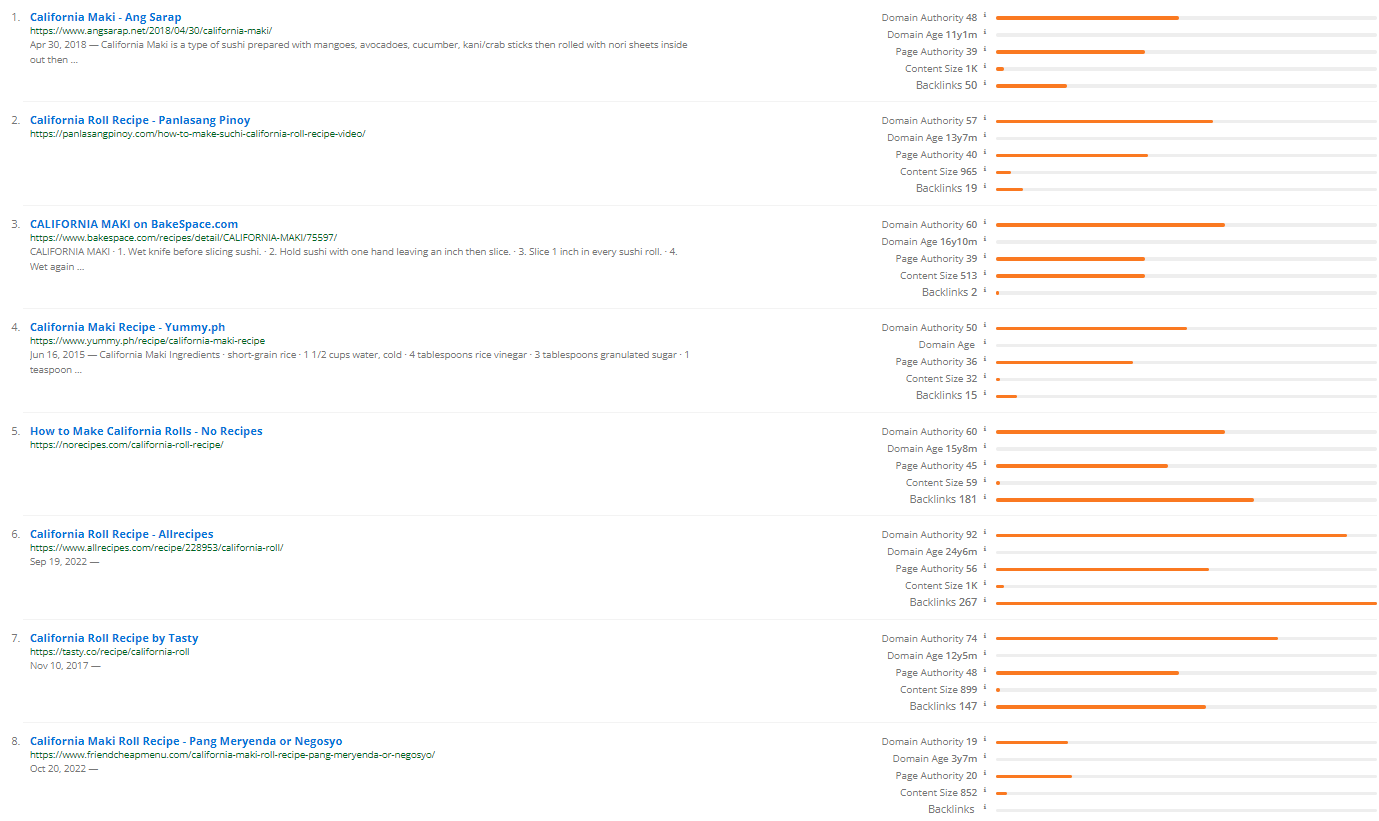

After checking this keyword in the SEMScoop tool, we should definitely be able to outrank some of these pages for this keyword. Remember to include the keyword in your headline, meta description, and in your URL slug, and do your on-site SEO properly. I highly recommend a plugin called YOAST! – It will help you along the way on your on-site SEO journey. With a search volume of 1900 every month, we should be able to get some good traffic as well.
Now, we need to check the content quality of these hits. Just take a quick look through the first page results and see if you can make the content better than what’s already ranking. Get a feel for the quality of the content, and make a better content piece to outcompete them.
So there you have it. A quick, easy and free way to conduct long-tail keyword research and competitor analysis. After you have conducted this process you should have a list of 1 main keyword and 2-15 sub-keywords. Try to get the exact match of your main keyword into your text at a sufficient density level. Use the YOAST! plugin to help you monitor this. In addition, you should try to include as many of your secondary keywords as you can in your article as well. That said, make sure you’re writing in an active and natural voice.
Do you have another way to conduct free long-tail keyword research and competitor analysis? Let me know in the comments.
Related: Recommended Tools & Resources
Thank you for reading!